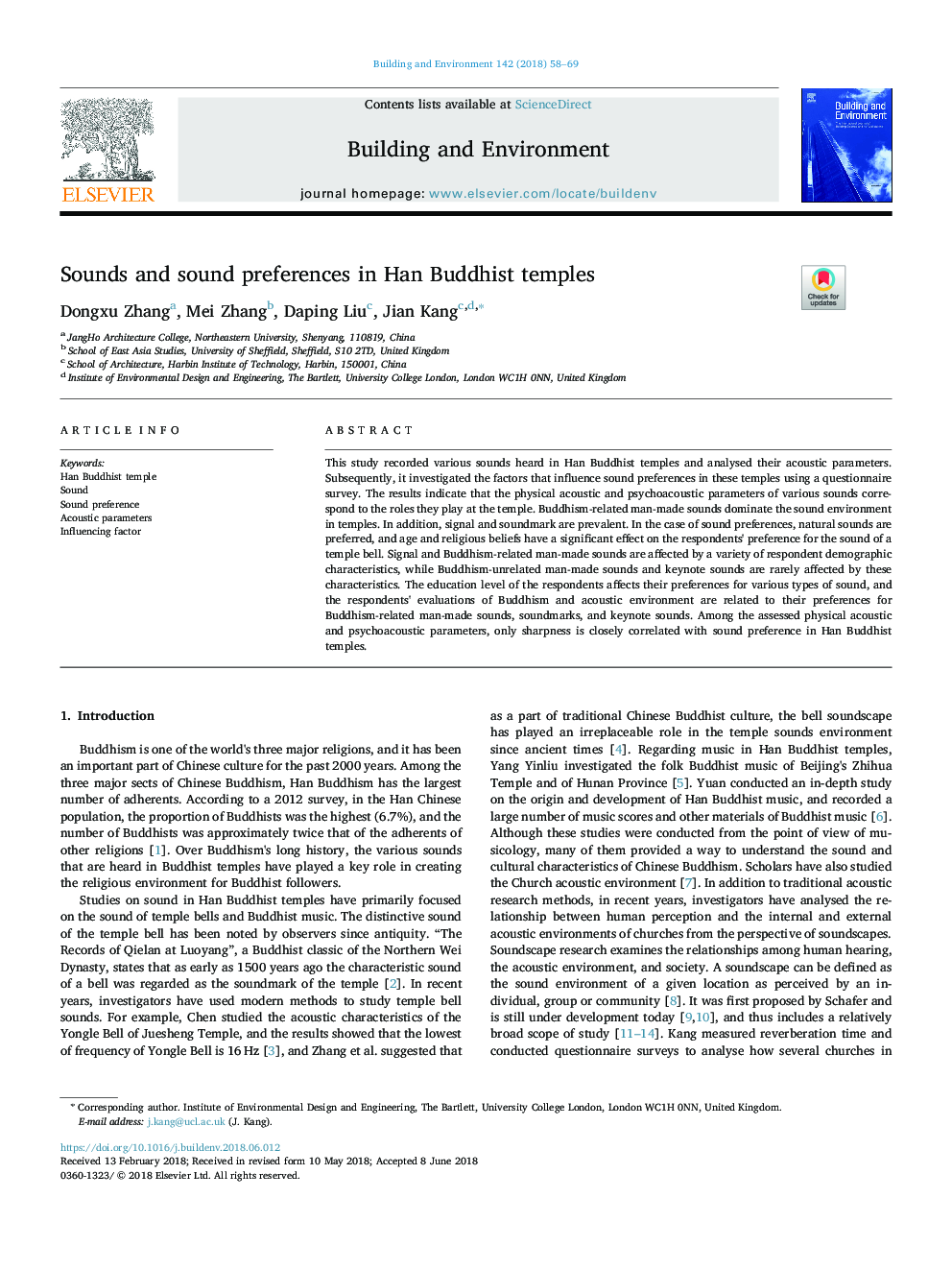| کد مقاله | کد نشریه | سال انتشار | مقاله انگلیسی | نسخه تمام متن |
|---|---|---|---|---|
| 6696757 | 1428350 | 2018 | 12 صفحه PDF | دانلود رایگان |
عنوان انگلیسی مقاله ISI
Sounds and sound preferences in Han Buddhist temples
ترجمه فارسی عنوان
صداها و ترجیحات صدا در معابد هان بودایی
دانلود مقاله + سفارش ترجمه
دانلود مقاله ISI انگلیسی
رایگان برای ایرانیان
کلمات کلیدی
معبد بودایی هان، صدا، ترجیح صدا، پارامترهای آکوستیک، عامل تاثیرگذار،
ترجمه چکیده
این مطالعه صداهای مختلفی را در معابد هان بودایی ثبت کرده و پارامترهای صوتی آنها را تحلیل می کند. سپس، عوامل موثر بر تنظیم صدا در این معابد را با استفاده از یک پرسشنامه بررسی کردند. نتایج نشان می دهد که پارامترهای آکوستیک و روانکاوی فیزیکی صداهای مختلف مربوط به نقش هایی هستند که در معبد بازی می کنند. صداهای ساخته شده مربوط به بودیسم به محیط صدا در معابد تسلط دارند. علاوه بر این، سیگنال و صدای گوینده شایع هستند. در مورد ترجیحات صوتی، صداهای طبیعی ترجیح داده می شوند و باورهای سنی و مذهبی تأثیر قابل توجهی بر ترجیح پاسخ دهندگان برای صدای زنگ معبد دارند. صداهای ساخته شده مربوط به سیگنال و بودیسم تحت تأثیر چندین ویژگی جمعیت شناختی قرار می گیرند، در حالی که صداهایی که انسان ساخته نشده است و صدای اصلی آن به ندرت تحت تاثیر این خصوصیات هستند. سطح تحصیلات پاسخ دهندگان بر ترجیحات خود برای انواع مختلف صدا تأثیر می گذارد و ارزیابی پاسخ دهندگان از بودیسم و محیط صوتی مربوط به تنظیمات آنها برای صداهای ساخته شده انسان بودیسم، صداهای صدا و صدای اصلی است. در میان پارامترهای آکوستیک و روانکاوی فیزیکی، تنها تیز بودن با ترجیح صدا در معابد هان بودیسم ارتباط دارد.
موضوعات مرتبط
مهندسی و علوم پایه
مهندسی انرژی
انرژی های تجدید پذیر، توسعه پایدار و محیط زیست
چکیده انگلیسی
This study recorded various sounds heard in Han Buddhist temples and analysed their acoustic parameters. Subsequently, it investigated the factors that influence sound preferences in these temples using a questionnaire survey. The results indicate that the physical acoustic and psychoacoustic parameters of various sounds correspond to the roles they play at the temple. Buddhism-related man-made sounds dominate the sound environment in temples. In addition, signal and soundmark are prevalent. In the case of sound preferences, natural sounds are preferred, and age and religious beliefs have a significant effect on the respondents' preference for the sound of a temple bell. Signal and Buddhism-related man-made sounds are affected by a variety of respondent demographic characteristics, while Buddhism-unrelated man-made sounds and keynote sounds are rarely affected by these characteristics. The education level of the respondents affects their preferences for various types of sound, and the respondents' evaluations of Buddhism and acoustic environment are related to their preferences for Buddhism-related man-made sounds, soundmarks, and keynote sounds. Among the assessed physical acoustic and psychoacoustic parameters, only sharpness is closely correlated with sound preference in Han Buddhist temples.
ناشر
Database: Elsevier - ScienceDirect (ساینس دایرکت)
Journal: Building and Environment - Volume 142, September 2018, Pages 58-69
Journal: Building and Environment - Volume 142, September 2018, Pages 58-69
نویسندگان
Dongxu Zhang, Mei Zhang, Daping Liu, Jian Kang,
